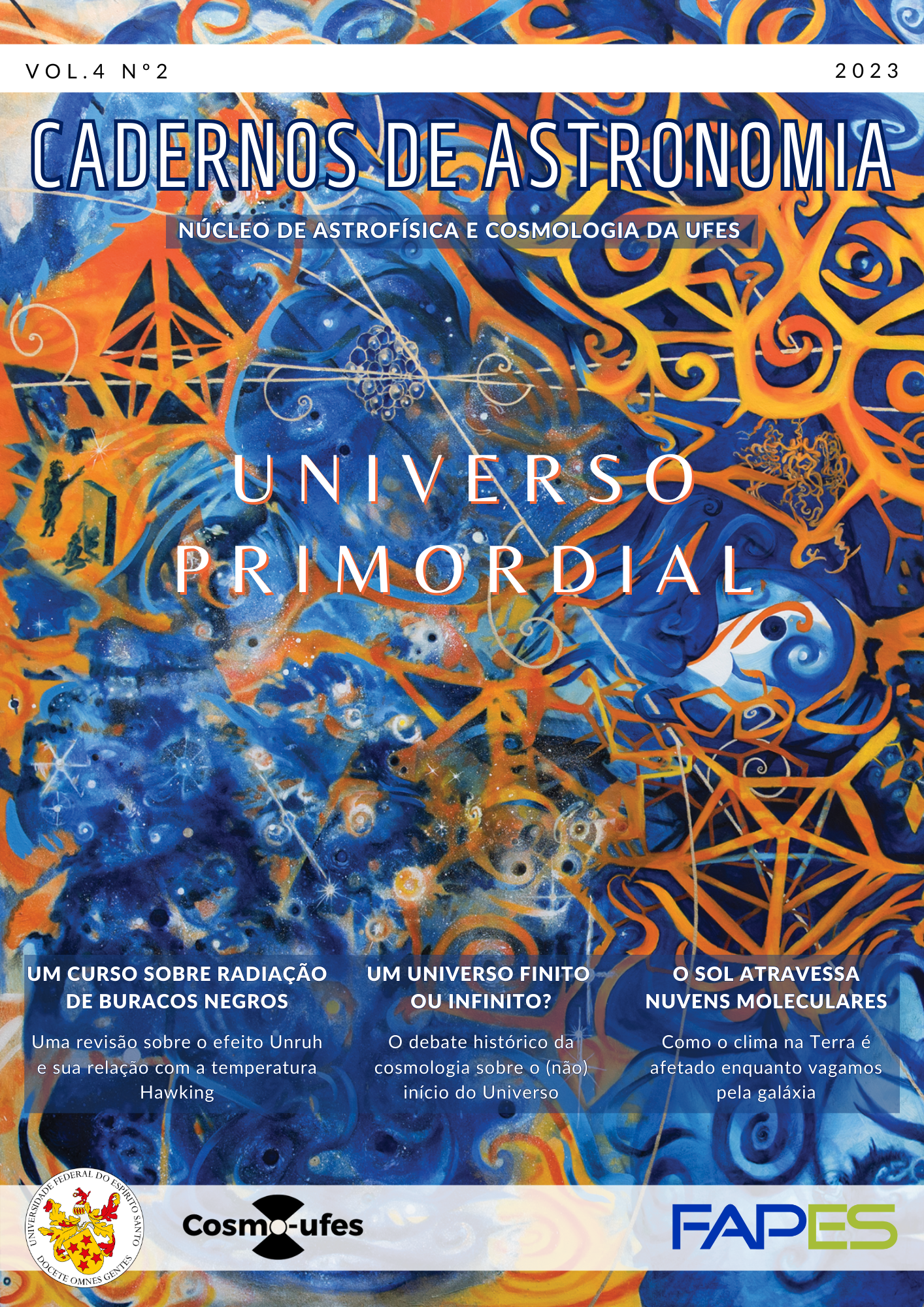The inflationary model: progress and challenges
DOI:
https://doi.org/10.47456/Cad.Astro.v4n2.41170Keywords:
cosmology, primordial universe, cosmic microwave background, cosmological inflationAbstract
After the development of the Standard Model of Cosmology, the Big Bang Model, it seemed that a satisfactory theory capable of describing the evolution of the universe from an initial hot and dense state had been built. However, some open questions led to the proposal of the Cosmological Inflationary model, which describes an accelerating expansion in the very early universe that would have lasted a fraction of a second, after which the universe has followed its evolution as predicted by the Big Bang model. Although today there are alternatives to Inflation that are capable of resolving the same issues, Inflation was the first theory within which it was possible to make consistent predictions about the structure of the Universe on large scales, like the distribution of galaxies, clusters, etc., as it provided a description for their origin.
In this article, the Inflationary Model will be introduced, from a historical and also mathematical perspective. The criticisms and challenges that surround this model nowadays will be addressed and the future perspectives for testing the inflationary model with new experiments will also be discussed.
Downloads
References
S. Tsujikawa, Introductory review of cosmic inflation, in 2nd Tah Poe School on Cosmology: Modern Cosmology (2003). ArXiv: hep-ph/0304257.
H. Kragh, Cosmology and Controversy (Princeton University Press, Princeton, 1999).
H. Kragh, The Big Bang (W. H. Freeman & Co., New York, 2001).
S. Weinberg, The First Three Minuts (revised edition) (Perseus Books, New York, 1993).
N. Aghanim et al., Planck 2018 results. VI. Cosmological parameters, Astron. Astrophys. 641, A6 (2020), [Erratum: Astron.Astrophys. 652, C4 (2021)]. ArXiv:1807.06209.
A. H. Guth, The Inflationary Universe: A Possible Solution to the Horizon and Flatness Problems, Phys. Rev. D 23, 347 (1981).
K. Sato, First Order Phase Transition of a Vacuum and Expansion of the Universe, Mon. Not. Roy. Astron. Soc. 195, 467 (1981).
A. Berera, I. G. Moss e R. O. Ramos, Warm Inflation and its Microphysical Basis, Rept. Prog. Phys. 72, 026901 (2009). ArXiv:0808.1855.
A. H. Guth e E. J. Weinberg, Could the Universe Have Recovered from a Slow First Order Phase Transition?, Nucl. Phys. B 212, 321 (1983).
A. D. Linde, A New Inflationary Universe Scenario: A Possible Solution of the Horizon, Flatness, Homogeneity, Isotropy and Primordial Monopole Problems, Phys. Lett. B 108, 389 (1982).
A. Albrecht e P. J. Steinhardt, Cosmology for Grand Unified Theories with Radiatively Induced Symmetry Breaking, Phys. Rev. Lett. 48, 1220 (1982). Referências
A. D. Linde, Chaotic Inflation, Phys. Lett. B 129, 177 (1983).
T. Biswas et al., Cosmological perturbations from statistical thermal fluctuations, Phys. Rev. D 88(2), 023517 (2013). ArXiv:1302.6463.
L. L. Graef, Constraining the spectrum of cosmological perturbations from statistical thermal fluctuations, Phys. Lett. B 819, 136418 (2021).
B. Ryden, Introduction to Cosmology (second edition) (Ohio State University, Ohio, 2016).
D. Baumann, Cosmology (Cambridge University Press, 2022).
V. Mukhanov, Physical Foundations of Cosmology (Cambridge University Press, Oxford, 2005).
S. Dodelson, Modern Cosmology (Academic Press, Amsterdam, 2003).
S. Weinberg, Cosmology (Oxford University Press, Oxford, 2008).
R. Brandenberger e P. Peter, Bouncing Cosmologies: Progress and Problems, Found. Phys. 47(6), 797 (2017). ArXiv:1603.05834.
N. Pinto Neto, Perturbations in bouncing cosmological models, Int. J. Mod. Phys. D 13, 1419 (2004). ArXiv:hep-th/0410225.
M. Novello e S. E. P. Bergliaffa, Bouncing Cosmologies, Phys. Rept. 463, 127 (2008). ArXiv:0802.1634.
L. L. Graef et al., Dynamics of Cosmological Perturbations and Reheating in the Anamorphic Universe, JCAP 04, 004 (2017). ArXiv:1701.02654.
J. Khoury et al., The Ekpyrotic universe: Colliding branes and the origin of the hot big bang, Phys. Rev. D 64, 123522 (2001). ArXiv:hep-th/0103239.
R. H. Brandenberger, Principles, progress and problems in inflationary cosmology, AAPPS Bull. 11, 20 (2001). ArXiv: astro-ph/0208103.
J. Martin e R. H. Brandenberger, The TransPlanckian problem of inflationary cosmology, Phys. Rev. D 63, 123501 (2001). ArXiv: hep-th/0005209.
E. G. M. Ferreira e R. Brandenberger, The Trans-Planckian Problem in the Healthy Extension of Horava-Lifshitz Gravity, Phys. Rev. D 86, 043514 (2012). ArXiv:1204.5239.
A. Ashtekar e E. Bianchi, A short review of loop quantum gravity, Rept. Prog. Phys. 84(4), 042001 (2021). ArXiv:2104.04394.
I. Agullo e P. Singh, Loop Quantum Cosmology (WSP, 2017), 183–240. ArXiv:1612.01236.
G. S. Vicente, R. O. Ramos e L. L. Graef, Gravitational particle production and the validity of effective descriptions in loop quantum cosmology, Phys. Rev. D 106(4), 043518 (2022). ArXiv:2207.00435.
A. H. Guth, Eternal inflation and its implications, J. Phys. A 40, 6811 (2007). ArXiv: hep-th/0702178.
A. Ijjas, P. J. Steinhardt e A. Loeb, Inflationary paradigm in trouble after Planck2013, Phys. Lett. B 723, 261 (2013). ArXiv:1304.2785.
A. H. Guth, D. I. Kaiser e Y. Nomura, Inflationary paradigm after Planck 2013, Phys. Lett. B 733, 112 (2014). ArXiv:1312.7619.
A. Linde, Inflationary Cosmology after Planck , in Post-Planck Cosmology: Lecture Notes of the Les Houches Summer School: Volume 100, July 2013, editado por C. Deffayet et al. (2015), 230–316. ArXiv:1402.0526.
A. Ijjas, P. J. Steinhardt e A. Loeb, Inflationary schism, Phys. Lett. B 736, 142 (2014). ArXiv:1402.6980.
P. Ade et al., The Simons Observatory: Science goals and forecasts, JCAP 02, 056 (2019). ArXiv:1808.07445.
K. N. Abazajian et al., CMB-S4 Science Book, First Edition (2016). ArXiv:1610.02743.
S. Hanany et al., PICO: Probe of Inflation and Cosmic Origins (2019). ArXiv:1902.10541.
D. Paoletti, The LiteBIRD mission, PoS ICHEP2022, 085 (2022).
Downloads
Published
How to Cite
Issue
Section
License
Copyright (c) 2023 Leila Lobato Graef

This work is licensed under a Creative Commons Attribution 4.0 International License.






